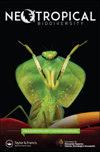DNA条形码方法鉴定厄瓜多尔淡水系统中分离的微藻
IF 0.8
Q4 ECOLOGY
引用次数: 6
摘要
摘要使用合适的DNA条形码和生成具有参考序列的数据库被认为是鉴定绿藻和蓝藻微藻的一种有前景的方法。在本研究中,我们使用双条形码方法对从厄瓜多尔淡水系统分离的菌株进行了分子表征和鉴定。叶绿体的靶序列是18S rDNA和rbcL基因,蓝藻的靶序列为16S rDNA及16S–23S rDNA基因间间隔区(ITS)。我们报道了20个不同的叶绿素门分子操作分类单元(MOTU)和10个蓝藻门的DNA条形码。我们的结果表明,18SV4高变区(300bp)足以区分分离株,但rbcL是Scedesmaceae和Chlorellaceae菌株属鉴定的决定因素。在蓝藻门中,两个条形码都能实现10个MOTU中9个MOTU的属级分配。这些结果强调了在小核糖体亚基序列之外添加第二个条形码以改进分子鉴定的必要性。此外,本研究对目前记录的厄瓜多尔微藻条形码序列做出了重大贡献,使其可用于未来的比较多样性研究。本文章由计算机程序翻译,如有差异,请以英文原文为准。
DNA barcoding approach to characterize microalgae isolated from freshwater systems in Ecuador
ABSTRACT The use of suitable DNA barcodes and the generation of databases with reference sequences have been considered a promissory approach for the identification of Chlorophyta and Cyanophyta microalgae. In this study, we carried out a molecular characterization and identification of strains isolated from freshwater systems in Ecuador using a dual barcode method. The target sequences for Chlorophyta were 18S rDNA and rbcL genes, and 16S rDNA and 16S–23S rDNA intergenic spacer (ITS) for Cyanophyta. We reported these DNA barcodes for 20 different Molecular Operational Taxonomic Units (MOTUs) for Chlorophyta and 10 for Cyanophyta. Our results show that the 18S V4 hypervariable region (300 bp) is sufficient for differentiating between isolates, but rbcL is a determinant for genus identification in Scenedesmaceae and Chlorellaceae strains. In Cyanophyta, both barcodes enabled the genus-level assignment of 9 out of 10 MOTUs. These results highlight the necessity of a second barcode additional to small ribosomal subunit sequences to improve molecular identification. Furthermore, the present study significantly contributes to the body of Ecuadorian barcode sequences of microalgae that are currently documented, making them available for future comparative diversity studies.
求助全文
通过发布文献求助,成功后即可免费获取论文全文。
去求助
来源期刊

Neotropical Biodiversity
Environmental Science-Ecology
CiteScore
1.80
自引率
0.00%
发文量
39
审稿时长
24 weeks
 求助内容:
求助内容: 应助结果提醒方式:
应助结果提醒方式:


